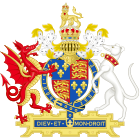Ecclesiastical Licences Act 1533 facts for kids
| Act of Parliament | |

|
|
| Long title | An Acte for the exoneracion from exaccions payde to the See of Rome. |
|---|---|
| Citation | 25 Hen. 8. c. 21 |
|
Status: Amended
|
|
| Revised text of statute as amended | |
The Ecclesiastical Licences Act 1533 (25 Hen. 8. c. 21) is also known as the Act Concerning Peter's Pence and Dispensations. It was an important law passed by the Parliament of England. This Act became law in early 1534. It made it illegal to send money called Peter's Pence and other payments to Rome.
This law was a big step in the English Reformation. This was a time when England broke away from the authority of the Pope and the Catholic Church. Even today, parts of this Act are still in force in Great Britain. Thanks to this Act, the Archbishop of Canterbury can give out special academic degrees called Lambeth degrees.
Contents
History of the Act
This Act was created during a time of big changes in England. King Henry VIII wanted to end the Pope's power in England. This law was one of many steps he took to make England more independent.
What was Peter's Pence?
Peter's Pence was a yearly payment made to the Pope. It was a small amount, just one penny, from each household that owned a certain amount of land. People in England had been paying it since the time of King Alfred. By the 1100s, the total amount for all of England was set at £200 per year.
Even though it wasn't the largest payment to Rome, this Act specifically mentioned Peter's Pence. Historians believe this was because ordinary people, not just church leaders, paid it. This might have made it seem more unfair to the public.
New Powers for the Archbishop
The Act stopped Peter's Pence and all other payments to Rome. It also gave new powers to the Archbishop of Canterbury. Before this Act, the Pope used to give out special permissions called dispensations. These were like special exceptions to church rules. For example, they might allow someone to marry a distant relative.
Now, the Archbishop of Canterbury could give out these permissions instead. The fees for these permissions were set by the law. If a fee was over £4, the King had to agree to it. His agreement was shown by the Great Seal of the Realm.
How the Bill Became Law
The idea for this law, called a Bill, was first discussed in the Commons. On March 12, 1534, the Commons passed the Bill. Some historians think the Commons added parts to the Bill that said the Act was not meant to go against the main beliefs of the Christian faith. The Bill also gave the King power to check on monasteries that had been free from the Archbishop's control. It also stopped English clergy from going to religious meetings abroad.
When the Bill went to the Upper House, some new parts were added. The Lords passed the Bill on March 20. The Commons quickly agreed to the new parts. However, on the very last day of the Parliament session, one more important part was added. This part gave the King the power to cancel the whole Act, or just a part of it, before June 24.
Historians believe King Henry VIII wanted this power to have something to bargain with the Pope. The French King had recently tried to help Henry make peace with Pope Clement VII. But this final part of the Act was never used because the French peace efforts failed.
Main Ideas of the Act
The Ecclesiastical Licences Act 1533 was very important for showing England's independence.
The Preamble
The beginning part of the Act, called the preamble, was written like a request from the Commons to the King. It was one of the first times a law mentioned the Pope taking too much power, calling it "papal usurpation."
It also strongly stated that England had "no superior under God, but only your Grace" (meaning the King). This showed that England believed its King was the highest authority, not the Pope. The preamble also said that the King's "imperial crown" (his royal power) was being weakened by the Pope's "unreasonable and uncharitable usurpations." This meant the Pope was taking power that didn't belong to him.
This preamble was later removed from the law in 1969.
Key Sections Still in Force
While many parts of the Act have been changed or removed over time, some important sections remain. For example, Section 5 talks about how special permissions (faculties) are recorded. Section 11 explains what happens if the Archbishop refuses to grant a licence. It also mentions that the Chancellor of the High Court can handle some of these duties.
Categories

